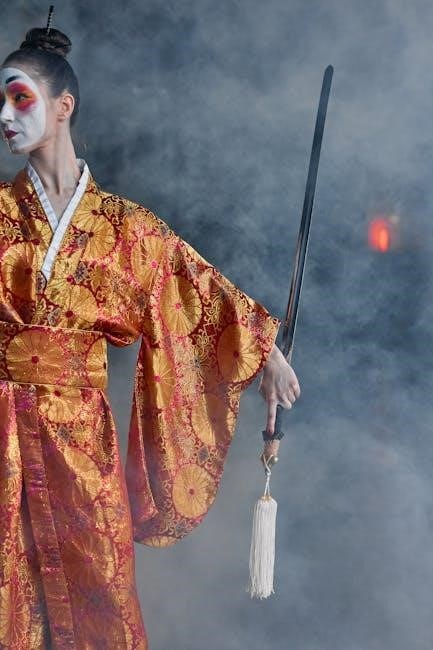Maxine Hong Kingston’s The Woman Warrior is a groundbreaking memoir blending autobiography and mythology‚ exploring cultural identity‚ gender roles‚ and the immigrant experience‚ becoming a classic in feminist literature․
Overview of “The Woman Warrior”
The Woman Warrior by Maxine Hong Kingston is a memoir that blends autobiography‚ mythology‚ and folklore to explore the experiences of a Chinese-American woman․ Published in 1976‚ the book is divided into five interconnected sections‚ each delving into themes of cultural identity‚ gender roles‚ and the immigrant experience․ Kingston weaves stories of her childhood in California with tales of her mother’s life in rural China‚ creating a narrative that challenges traditional genre classifications․ The memoir is both a personal journey and a broader exploration of the complexities of womanhood‚ cultural heritage‚ and belonging‚ making it a landmark work in feminist and ethnic literature․
Maxine Hong Kingston’s Background
Maxine Hong Kingston‚ born on October 27‚ 1940‚ in Stockton‚ California‚ is a Chinese-American author and poet․ Her parents were Chinese immigrants who operated a laundry and gambling house․ Kingston grew up in a cultural mix of traditional Chinese values and American influences‚ which deeply shaped her writing․ She earned a bachelor’s degree in English from the University of California‚ Berkeley‚ and later taught creative writing․ Her experiences as a Chinese-American woman‚ along with her family’s stories and myths‚ inspired her groundbreaking memoir‚ The Woman Warrior․ Kingston’s work has been widely acclaimed‚ earning her numerous awards‚ including the National Book Award‚ and establishing her as a pivotal figure in feminist and ethnic literature․
Significance of the Memoir
The Woman Warrior holds profound significance as a pioneering work in feminist and ethnic literature‚ offering a unique voice to the experiences of Chinese-American women․ By blending personal narrative with myth‚ Kingston challenges traditional storytelling and gives voice to silenced women․ The memoir addresses cultural identity‚ gender roles‚ and the immigrant experience‚ resonating deeply with readers․ Its innovative style has influenced both feminist and ethnic studies‚ while its exploration of personal and cultural heritage continues to inspire new generations․ Kingston’s work remains a landmark in contemporary literature‚ celebrated for its emotional depth and cultural insight․

Structure of the Book
The Woman Warrior is divided into five self-contained parts‚ blending Kingston’s California childhood with her mother’s rural China stories‚ enriched with folklore and myth․
Division into Five Parts
The Woman Warrior is structured into five distinct sections‚ each exploring different facets of Kingston’s life and heritage; The first part‚ “No-Name Woman‚” delves into family secrets and cultural taboos through the story of Kingston’s forgotten aunt․ “White Tigers” imagines her as a mythical woman warrior‚ blending fantasy with personal struggle․ “Shaman” highlights her mother’s strength and resilience‚ while “At the Western Palace” recounts her aunt’s tragic immigration experience․ The final section‚ “A Song for a Barbarian Reed Pipe‚” focuses on Kingston’s journey to find her voice and reconcile her dual identity․ This structure seamlessly intertwines memoir and myth‚ creating a rich narrative tapestry․

Part 1: No-Name Woman

In the first section of The Woman Warrior‚ Kingston explores the story of her forgotten aunt‚ who was ostracized for adultery and ultimately took her own life․ Through vivid imaginings‚ Kingston reconstructs her aunt’s life‚ considering multiple narratives that could explain her fate․ This exploration delves into themes of cultural identity‚ family secrets‚ and the suppression of women in traditional Chinese society․ By giving voice to her nameless aunt‚ Kingston confronts the silences and taboos within her own heritage‚ reflecting on how these stories shape her understanding of herself and her place within her family’s history․
Part 2: White Tigers

In this section‚ Kingston imagines herself as a legendary woman warrior‚ embarking on a mythical journey to train in the mountains and avenge her people․ This fantastical narrative contrasts with her real-life struggles as a Chinese-American woman facing sexism and racism․ Kingston reflects on the societal belittlement of girls in her community and her own frustration with systemic racism․ She draws a connection between her warrior persona and her everyday self‚ emphasizing the power of words as a shared strength․ This duality highlights her internal conflict and the resilience needed to navigate cultural and personal challenges․ The section blends fantasy and reality‚ showcasing Kingston’s unique storytelling style․
Part 3: Shaman
This section focuses on Kingston’s mother‚ Brave Orchid‚ a powerful figure who bridges the worlds of myth and science․ After losing her first two children‚ Brave Orchid becomes a respected doctor and midwife in her village․ Kingston recounts her mother’s encounters with supernatural beings‚ such as exorcising a monstrous creature and escaping a half-man‚ half-ape․ These stories highlight Brave Orchid’s strength and her ability to navigate both the spiritual and physical realms․ Through her mother’s journey‚ Kingston explores themes of resilience‚ cultural tradition‚ and the blending of folklore with personal history‚ creating a vivid portrait of a woman who defies ordinary boundaries․
Part 4: At the Western Palace
This section shifts to Brave Orchid’s life in California‚ focusing on her sister‚ Moon Orchid‚ who immigrates after being abandoned by her husband․ Brave Orchid devises dramatic plans to reunite the couple and confront the husband’s second wife‚ but these efforts fail‚ leading to Moon Orchid’s mental collapse and eventual death․ Kingston portrays the devastating impact of cultural displacement and the fragility of traditional values in a new world․ The story underscores the emotional toll on Brave Orchid’s Americanized children‚ particularly Kingston‚ who grapples with the complexities of her heritage and identity in a foreign land․
Part 5: A Song for a Barbarian Reed Pipe
In this final section‚ Kingston reflects on her childhood struggles with communication and identity․ She recalls bullying a silent Chinese girl‚ symbolizing her internalized self-hatred․ Kingston eventually finds her voice‚ standing up to her parents and rejecting their expectations․ However‚ this act distances her from her heritage’s mystical aspects․ Through writing‚ she reconnects with her cultural roots‚ ending with the story of a noblewoman who sings beautifully in captivity․ This part emphasizes Kingston’s journey of self-discovery‚ blending personal narrative with myth to explore the tension between cultural identity and individual expression․

Themes Explored
The memoir explores themes of cultural identity‚ gender roles‚ and the immigrant experience‚ blending personal narrative with mythology to examine family heritage and societal expectations․
Cultural Identity
Maxine Hong Kingston explores cultural identity by blending Chinese heritage with American life‚ reflecting her struggle to reconcile these dual worlds․ Through storytelling‚ she navigates the tension between traditional Chinese values and the realities of growing up in America․ The memoir delves into the suppression of women’s voices and the silencing of cultural narratives‚ as seen in the story of her No-Name Aunt․ Kingston’s journey is a quest to understand her own identity‚ bridging the gap between her family’s past and her present‚ ultimately finding a voice that honors both her heritage and her individual experience․
Gender Roles and Feminism
Maxine Hong Kingston critiques traditional Chinese gender roles‚ highlighting the oppression of women through stories like her No-Name Aunt‚ who was ostracized for adultery․ Kingston challenges these norms by imagining her aunt’s life‚ giving her a voice and dignity․ The memoir also reflects Kingston’s personal struggle with sexism in her community‚ where girls were belittled and silenced․ Through her writing‚ Kingston empowers women by reclaiming their stories and challenging patriarchal expectations‚ ultimately advocating for feminist ideals and self-expression․ Her work underscores the resilience of women in the face of societal constraints‚ offering a powerful feminist perspective․
Immigrant Experience
Maxine Hong Kingston’s The Woman Warrior vividly portrays the challenges of immigration through her family’s journey from China to America․ The memoir explores cultural dislocation‚ as Kingston navigates her Chinese heritage and American upbringing․ Her mother‚ Brave Orchid‚ embodies the struggles of adaptation‚ transitioning from a respected doctor in China to a laborer in the U․S․ Kingston also reflects on her own experiences with racism and the tension between preserving traditions and embracing a new identity․ The book captures the emotional and societal barriers immigrants face‚ offering a poignant exploration of belonging and identity in a foreign land․
Family and Heritage
In The Woman Warrior‚ Maxine Hong Kingston explores the intricate ties of family and heritage‚ weaving personal and mythical narratives․ Her aunt’s tragic story‚ the No-Name Woman‚ symbolizes the silencing of women and the weight of cultural secrets․ Kingston’s mother‚ Brave Orchid‚ emerges as a powerful figure‚ blending traditional wisdom with modern resilience․ The memoir delves into the intergenerational transmission of stories‚ highlighting how family history shapes identity․ Kingston’s journey to understand her heritage reflects the tension between honoring tradition and forging a personal path‚ ultimately revealing the enduring influence of family on her sense of self and culture․
Literary Style and Genre
The Woman Warrior blends memoir and mythology‚ using folklore and non-linear narrative to explore identity and culture‚ defying traditional genre classification with its innovative storytelling approach․
Blend of Memoir and Mythology
Maxine Hong Kingston’s The Woman Warrior masterfully combines personal memoir with Chinese folklore and mythology‚ creating a unique narrative that transcends traditional genre boundaries․ By intertwining her childhood experiences in California with mythical tales‚ Kingston explores themes of identity‚ culture‚ and family․ This blend allows her to voice silenced stories‚ particularly those of women‚ while connecting her American reality to her Chinese heritage․ The fusion of fact and fantasy enables Kingston to express the complexities of her dual identity‚ making the memoir both deeply personal and universally relatable․ This innovative approach challenges readers to rethink the boundaries of storytelling and truth․
Use of Folklore and Myth
Maxine Hong Kingston intricately weaves Chinese folklore and mythology into her narrative‚ using stories like the “No-Name Woman” and the legendary “Woman Warrior” to explore identity and cultural heritage․ These myths serve as a bridge between her American present and Chinese past‚ allowing her to voice silenced stories and challenge traditional narratives․ By reimagining these tales‚ Kingston not only preserves her heritage but also reinterprets it to reflect the experiences of Chinese-American women․ This use of folklore and myth enriches the memoir‚ blending the fantastical with the personal to create a layered‚ evocative exploration of identity and belonging․
Non-Linear Narrative
The Woman Warrior employs a non-linear narrative‚ blending past and present‚ reality and myth․ Kingston jumps between her childhood in California and her mother’s life in China‚ weaving folklore and personal history․ This structure mirrors her internal journey‚ as she navigates cultural dislocation and identity․ The memoir’s fragmented form reflects the disjointedness of her experience‚ merging mythic tales with autobiographical vignettes․ By defying chronological order‚ Kingston creates a complex tapestry that underscores the fluidity of memory and the interplay between tradition and personal narrative‚ offering a unique perspective on the immigrant and feminist experience․ This style enhances the book’s emotional and thematic depth․
Character Analysis
The memoir explores key characters‚ including the No-Name Aunt‚ the mythical Woman Warrior‚ Brave Orchid‚ Moon Orchid‚ and Kingston herself‚ each embodying different facets of identity and resilience․

The No-Name Aunt
The No-Name Aunt‚ Kingston’s unnamed aunt‚ is a pivotal figure in the memoir‚ symbolizing the silenced women of traditional Chinese culture․ Her tragic story—drowning herself and her illegitimate child after being shunned by her village—haunts Kingston‚ who imagines multiple narratives to fill the gaps of her aunt’s life․ Through this‚ Kingston critiques the rigid moral codes and gender roles that condemned her aunt to obscurity․ The aunt’s story serves as a metaphor for the suppression of women’s voices and the intergenerational trauma carried by Kingston’s family‚ highlighting the tension between cultural heritage and personal identity․
The Woman Warrior
The Woman Warrior is a central figure in Kingston’s memoir‚ embodying the strength and resilience of Chinese women․ Kingston imagines herself as a legendary warrior‚ trained in mythical mountains‚ symbolizing female empowerment and cultural pride․ This fantastical identity contrasts with her real-life struggles as a Chinese-American woman facing sexism and racism․ The warrior archetype allows Kingston to explore themes of identity‚ power‚ and the immigrant experience‚ blending myth with personal narrative to create a powerful symbol of resistance and self-discovery‚ reflecting her journey to find her voice and reclaim her heritage․
Brave Orchid
Brave Orchid‚ Kingston’s mother‚ is a formidable figure in the memoir‚ embodying strength and resilience․ She overcomes adversity‚ including the loss of her first two children and her husband’s absence in America‚ by pursuing medical school and becoming a respected doctor and midwife in her village․ Her stories‚ filled with encounters with ghosts and supernatural beings‚ highlight her ability to bridge the mythic and scientific worlds․ Brave Orchid’s character represents the blending of tradition and modernity‚ as well as the challenges of balancing cultural identity with personal ambition‚ making her a pivotal figure in Kingston’s exploration of family and heritage․
Moon Orchid
Moon Orchid‚ Brave Orchid’s sister‚ is portrayed as gentle and ineffectual‚ contrasting sharply with her sibling’s strength․ Her story in the memoir highlights her tragic fate as a woman unable to adapt to the challenges of immigration․ Abandoned by her husband in America‚ Moon Orchid’s life unravels‚ leading to her mental decline and eventual death․ Kingston uses her aunt’s story to explore themes of cultural displacement and the struggles of navigating a new world․ Moon Orchid’s character serves as a poignant reminder of the vulnerabilities faced by immigrant women in a society vastly different from their own․
Maxine Hong Kingston

Maxine Hong Kingston is a celebrated Chinese-American author‚ best known for her groundbreaking memoir The Woman Warrior․ Born in 1940 in Stockton‚ California‚ Kingston grew up in a culturally rich but challenging environment‚ navigating her Chinese heritage and American upbringing․ Her work often explores themes of identity‚ culture‚ and gender‚ blending personal narrative with mythology․ Kingston’s writing has earned her numerous accolades‚ including the National Book Award‚ and has significantly influenced feminist and ethnic studies․ Through her unique storytelling‚ she bridges the gap between her dual cultural identities‚ offering profound insights into the immigrant experience and the resilience of women․
Cultural and Historical Context
The memoir explores the Chinese-American experience‚ blending traditional Chinese values with American culture‚ and examines the impact of immigration on identity and family dynamics․
Chinese-American Experience
The Woman Warrior vividly portrays the challenges of navigating dual cultural identities‚ exploring the tensions between traditional Chinese values and American life․ Kingston delves into the immigrant experience‚ highlighting the struggles of cultural adaptation‚ language barriers‚ and societal expectations․ Her narrative reflects the broader Chinese-American community’s journey‚ blending personal and collective histories․ The memoir also examines the intergenerational conflicts between immigrant parents and their American-born children‚ offering a poignant look at identity formation and the quest for belonging in a multicultural society․ Kingston’s work remains a powerful exploration of the Chinese-American experience‚ resonating deeply with readers․
Traditional Chinese Values
The Woman Warrior explores the profound influence of traditional Chinese values on Kingston’s life and identity․ These values‚ emphasizing family honor‚ female modesty‚ and societal expectations‚ often clash with her American upbringing․ Kingston examines how these traditions shape gender roles‚ silence women‚ and enforce conformity․ The memoir critiques the rigid moral codes that governed her mother’s generation‚ such as the stigma surrounding her unnamed aunt’s adultery․ Through these narratives‚ Kingston reveals the tension between preserving cultural heritage and embracing personal freedom‚ highlighting the complexities of navigating traditional values in a modern context․

Impact of Immigration
The Woman Warrior vividly portrays the challenges of immigration through Kingston’s family experiences․ Her parents’ journey from China to America symbolizes cultural dislocation and adaptation․ The memoir highlights the struggles of balancing traditional values with the demands of a new society․ Kingston’s mother‚ Brave Orchid‚ embodies resilience as she navigates medical school and cultural barriers in America․ Conversely‚ her aunt Moon Orchid’s tragic fate illustrates the devastating consequences of displacement and the clash between old-world expectations and American realities․ Kingston’s narrative underscores the emotional and societal toll of immigration on individuals and families‚ revealing the complexities of identity and belonging in a foreign land․

Reception and Impact
Published in 1976‚ The Woman Warrior sparked controversy but gained acclaim for its unique blend of memoir and mythology․ It became a landmark in feminist and ethnic studies‚ earning critical praise and influencing literary discussions on identity and culture․
Initial Reception and Controversy
When The Woman Warrior was published in 1976‚ it sparked both acclaim and controversy․ Critics praised its innovative blend of memoir and mythology‚ hailing it as a groundbreaking work in feminist and ethnic literature․ However‚ some Chinese-American readers criticized Kingston for her portrayal of Chinese culture‚ accusing her of misrepresentation․ The book’s non-traditional narrative style and fusion of fantasy with reality also divided opinions․ Despite the backlash‚ the memoir resonated deeply with many‚ particularly women of color‚ who saw it as a powerful exploration of identity and resilience․ Its impact endured‚ shaping discussions on cultural authenticity and literary innovation․
Academic and Literary Recognition
The Woman Warrior earned widespread academic and literary acclaim‚ solidifying Maxine Hong Kingston’s status as a pivotal voice in contemporary literature․ The memoir received the National Book Critics Circle Award in 1976‚ recognizing its innovative storytelling and cultural depth․ Scholars praised its genre-defying structure‚ blending memoir with mythology‚ and its exploration of identity‚ gender‚ and immigration․ The book is now a staple in university curricula‚ particularly in feminist and ethnic studies‚ and continues to influence writers and researchers․ Its enduring relevance underscores Kingston’s contribution to expanding the boundaries of autobiographical writing and fostering diverse narratives in American literature․
Influence on Feminist and Ethnic Studies
The Woman Warrior has profoundly shaped feminist and ethnic studies‚ offering a powerful voice for Chinese-American women․ Kingston’s exploration of gender roles‚ cultural identity‚ and immigration challenges traditional narratives‚ inspiring scholars to reexamine intersectionality and representation․ The memoir’s blend of personal and mythological storytelling has influenced feminist theory‚ particularly in discussions of silenced voices and resilience․ Its impact extends to ethnic studies‚ providing a foundational text for understanding the complexities of diasporic experiences․ Kingston’s work continues to inspire new generations of writers and researchers‚ fostering diverse narratives and enriching academic discourse on identity and culture․
Maxine Hong Kingston’s The Woman Warrior leaves a lasting legacy as a profound exploration of cultural identity‚ blending personal and mythological narratives to redefine feminist literature․
The Woman Warrior explores themes of cultural identity‚ gender roles‚ and the immigrant experience․ Kingston examines the tension between Chinese traditions and American modernity‚ highlighting the struggles of navigating dual identities․ The memoir critiques patriarchal norms and the silencing of women‚ while celebrating female resilience․ It also delves into the complexities of family and heritage‚ blending personal narratives with mythological tales․ Kingston’s work underscores the fragmented nature of identity‚ offering a powerful commentary on belonging and self-discovery․ Through her unique storytelling‚ she bridges the gap between past and present‚ creating a timeless exploration of womanhood and cultural legacy․
Legacy of “The Woman Warrior”
The Woman Warrior has left an indelible mark on feminist and ethnic studies‚ becoming a landmark text in American literature․ Its innovative blend of memoir and mythology has inspired countless writers to explore their cultural identities․ Kingston’s work has been recognized with numerous awards and remains a foundational text in academic curricula․ By giving voice to silenced stories‚ it has empowered marginalized communities and fostered cross-cultural understanding․ The memoir’s exploration of identity‚ gender‚ and heritage continues to resonate‚ ensuring its relevance for future generations․ Its legacy lies in its ability to bridge cultural divides and challenge traditional narratives‚ cementing its place as a timeless classic․
Final Thoughts on Kingston’s Work
Maxine Hong Kingston’s The Woman Warrior remains a transformative work‚ blending memoir and mythology to explore identity‚ culture‚ and resilience․ Kingston’s unique voice and innovative storytelling have redefined the boundaries of autobiographical writing․ Her work not only reflects the struggles of Chinese-American women but also resonates universally‚ offering insights into the human experience․ By weaving personal and cultural narratives‚ Kingston creates a profound connection with readers‚ challenging them to confront their own identities and histories․ Her legacy endures as a testament to the power of storytelling and its ability to bridge cultural and generational divides․
